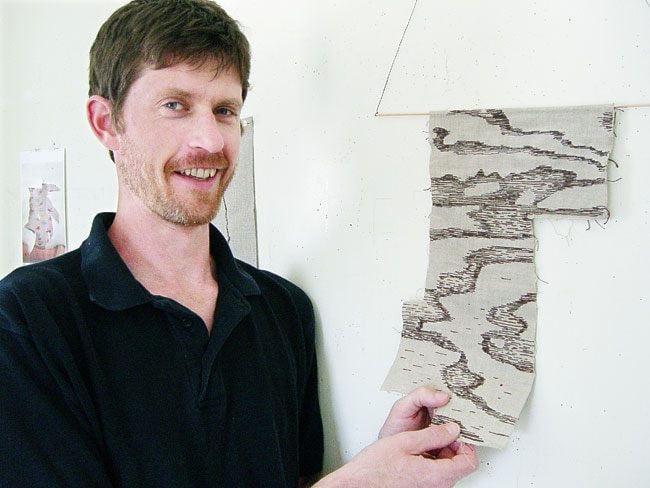DAWSON CITY
When Sean Alward talks about wood, his enthusiasm is infectious.
“What I like about plywood, particularly, is that its nature that’s been turned into a picture in a very simple, crude way,” says the Vancouver artist and construction worker.
Alward, in Dawson City as an artist-in-residence with the Klondike Institute for Art and Culture, is working on two projects.
He’s embroidering the patterns of plywood onto linen fabric and painting a series of abstract watercolours about one of Dawson’s former prostitute “cribs.”
Much of Alward’s art is inspired by the possibilities of how new metaphors or meanings appear when an object is removed from its usual surroundings and placed in a new context.
“Partly I’m interested in using a traditional painting material—linen is a traditional support for oil paintings—but with no paint,” he says. “As well as making a nature picture without a literal view of a landscape.”
The embroidery test patches were part of Alward’s plan before he arrived in the Yukon.
“I like the idea of taking the macho plywood and turning it into a loose wrinkly piece of fabric, unstretched, like a tapestry,” he says, pointing out a hand-stitched sample on the studio wall.
Alward’s watercolours are directly inspired by walking through Dawson’s alleys.
Called What the prostitute off 8th Avenue, Dawson City, saw, the series repeats the shape of a ceiling hole in a room rented by ladies of the Gold Rush demi-monde.
He’s painting different colour combinations within his finely cut stencil of the tear, filling sheet after sheet of medium-sized paper.
Each image has a distinct interior, but follows the hard-edged original form.
Looking back and forth between the original photograph and the paintings feels dream-like.
Alward creates translations: the abstract shape remains recognizable, but its meanings shift from image to image. The viewer begins to pick up moods from image to image as well, which evokes a feeling of slight hallucination.
Alward grins at the description.
“I imagine that while the prostitutes were at work they would do some daydreaming, some mental projecting out of the space they were in,” he says.
“When you’re looking and thinking in that space, it isn’t really any different than looking at any other historical space—what was it like for the people living here?” He compares the act of projecting ideas onto the past with the act of projecting meaning onto an abstract painting.
Now in mid-career, Alward’s main medium is painting, though he also makes drawings, sculptures and now textile art.
His technique of trying to “get under the skin” of an idea—or a historical person’s mind—appears early in Alward’s work.
One interesting example is his Wols Photo/Mirror Hybrid Paintings.
The early 20th-century German artist photographed himself in a drunken state, an unusual approach for the late 1930s.
A desire to understand Wols’ mindset drove Alward to match Wols’ features by wearing a moustache and altering his own hairline. He then painted six diptychs. Each has a copy of a Wols photograph on the left panel, and a self-portrait on the right panel that shows Alward’s attempts to mimic Wols’ expressions.
“If you’re trying to identify where is the art in an image, it’s quite literally the space between two things,” Alward says.
In his Dawson works, the art is in our experience of the space between how we know plywood looks and what we see in Alward’s textile. It is also in our mind’s movements as we compare the multiple ceiling portraits and imagine a working prostitute’s daydreams.
In his early teens, Alward was, “a pretty fanatical painter” and took his bachelor of fine arts at the Nova Scotia College of Art and Design.
A stint teaching English took him to Japan for a few years before he took his masters of fine arts at UBC.
He now alternates between painting, teaching fine art at various institutions in the Vancouver area, and doing construction work as a renovator.
He will be discussing these pieces, as well as previous art, on Thursday at 7:30 p.m. in the Klondike Institute for Art and Culture ballroom, free of charge. Alward’s work is also online at www.seanalward.com.
He’s at KIAC until mid-July.
Meg Walker is a freelance writer based in Dawson City.
